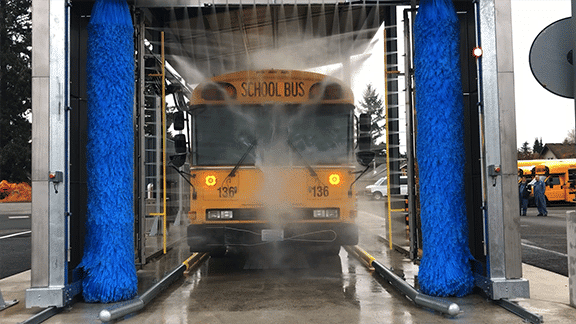Is your school district or public transit authority looking for a way to stand out from the competition? Look no further than implementing a consistent bus wash policy. In this article, we will explore how having a regular bus wash routine can give your organization an edge and contribute to its success.
Maintaining a clean and presentable fleet is more than just an aesthetic choice. It demonstrates a commitment to excellence and attention to detail that passengers and stakeholders appreciate. A dirty bus can project a negative image and may lead to decreased trust and satisfaction among your riders.
By incorporating a systematic and consistent bus wash policy, you can improve the overall appearance of your fleet, boost your organization’s reputation, and attract new riders. Additionally, regular washing can help extend the lifespan of your buses, minimizing maintenance costs and increasing their resale value.
In this article, we will delve into the benefits of a consistent bus wash policy and provide practical tips for implementing one in your school district or public transit authority. Don’t let the competition dirty your chances of success; uncover the advantages of a clean fleet today.
The Importance of Maintaining a Clean Fleet
A clean fleet is essential for several reasons. First and foremost, it creates a positive image for your school district or public transit authority. When passengers step onto a clean and well-maintained bus, they immediately feel more comfortable and confident in the service being provided. This positive first impression can lead to increased rider satisfaction and loyalty.
Moreover, a clean fleet also promotes safety. Dirt, grime, and debris on the exterior of the bus can obstruct visibility, making it harder for drivers to see pedestrians, cyclists, or other vehicles on the road. Additionally, a clean interior reduces the risk of slip and fall accidents due to spills or clutter.
Lastly, maintaining a clean fleet demonstrates your organization’s commitment to the environment. Regular bus washing removes pollutants, such as dirt, oil, and chemicals, which can harm the environment if left unchecked. By implementing a consistent bus wash policy, you contribute to cleaner air and water in your community.
Common Challenges in Keeping Buses Clean
While keeping buses clean is crucial, it often comes with its fair share of challenges. One common obstacle is the lack of time and resources. School districts and public transit authorities have numerous responsibilities and limited budgets, making it difficult to allocate sufficient time and money for regular bus washing.
Another challenge is the weather. Depending on your location, buses may be exposed to harsh conditions such as rain, snow, and salt during the winter months. These weather elements can quickly make a clean bus dirty, requiring more frequent washing.
Furthermore, improper washing techniques can also hinder your efforts in maintaining a clean fleet. Using incorrect cleaning agents or abrasive tools can damage the bus’s paint, windows, and other surfaces. It is crucial to train your staff on proper washing techniques to avoid any potential harm to the buses.
Benefits of a Consistent Bus Wash Policy
Implementing a consistent bus wash policy offers numerous benefits that go beyond just cleanliness. One of the most significant advantages is the improvement in your organization’s reputation. When your buses are consistently clean and well-maintained, passengers perceive your organization as professional and reliable. This positive reputation can lead to increased ridership and support from stakeholders.
Additionally, regular bus washing can extend the lifespan of your fleet. Dirt and grime can accumulate on the exterior, leading to corrosion and damage over time. By regularly washing away these contaminants, you can prevent premature wear and tear, ultimately reducing maintenance costs and increasing the resale value of your buses.
Moreover, a clean fleet contributes to a healthier and more pleasant environment for both passengers and staff. Regular bus washing eliminates germs, allergens, and odors that can accumulate inside the bus. This promotes better air quality and reduces the risk of illness among passengers and employees.
Choosing the Right Bus Wash System
Selecting the appropriate bus wash system is crucial for achieving the desired results. There are various options available, including manual washing, automatic brushes, touchless systems, and waterless cleaning solutions. Each system has its pros and cons, and the choice depends on factors such as budget, resource availability, and specific cleaning requirements.
Manual washing involves using a pressure washer, brushes, and cleaning agents to wash the bus by hand. This method offers flexibility and control over the cleaning process but requires more time and effort. Automatic brush systems are faster and more efficient, but they can potentially cause damage to the bus’s exterior if not used correctly.
Touchless systems use high-pressure water jets and specialized cleaning agents to remove dirt without physical contact. This method is gentle on the bus’s surfaces and reduces the risk of scratches or paint damage. Waterless cleaning solutions, on the other hand, use specially formulated sprays that dissolve and lift dirt without the need for water. This method is ideal for areas with water scarcity or restrictions.
When choosing a bus wash system, consider factors such as cost, efficiency, effectiveness, environmental impact, and maintenance requirements. It may be beneficial to consult with industry experts or seek recommendations from other school districts or public transit authorities that have successfully implemented a bus wash policy.
Implementing and Enforcing the Bus Wash Policy
Implementing a bus wash policy requires careful planning and clear communication with all relevant stakeholders. Start by establishing a set schedule for bus washing based on your organization’s needs and resources. Determine how often each bus should be washed and create a comprehensive washing schedule that can be easily followed.
Next, assign responsibility for overseeing the bus wash policy. This individual or team will be responsible for monitoring compliance, addressing any issues that arise, and ensuring that the washing schedule is consistently followed. It is essential to provide them with the necessary authority and resources to carry out their duties effectively.
To enforce the bus wash policy, consider implementing a system of checks and balances. Conduct regular inspections to ensure that buses are being washed according to the schedule and using the appropriate techniques. Develop a reporting system where drivers or maintenance staff can document any concerns or issues related to bus cleanliness.
Consistent communication is key to the success of the bus wash policy. Regularly remind staff of the importance of maintaining a clean fleet and the specific guidelines and expectations for bus washing. Provide training sessions or workshops to educate employees on proper washing techniques, the use of cleaning agents, and the importance of attention to detail.
Training Staff on Proper Bus Washing Techniques
Properly training staff on bus washing techniques is crucial to ensure effective and safe cleaning practices. Start by providing comprehensive training on the correct use of cleaning agents, equipment, and tools. Emphasize the importance of following manufacturer instructions and safety guidelines to avoid any damage to the buses or harm to personnel.
Additionally, train staff on the proper sequence and techniques for washing different areas of the bus, including the exterior, windows, floors, and seats. Demonstrate the correct use of brushes, pressure washers, and other cleaning tools to avoid any accidental damage or improper cleaning.
Consider organizing refresher training sessions periodically to reinforce proper techniques and address any new developments or changes in cleaning procedures. Encourage open communication and feedback from staff to continuously improve the bus washing process.
Monitoring and Evaluating the Effectiveness of the Bus Wash Policy
Monitoring and evaluating the effectiveness of your bus wash policy is essential to ensure its ongoing success. Regularly assess the cleanliness of your fleet to identify any areas for improvement or potential issues. This can be done through visual inspections, customer feedback, or surveys.
It is also beneficial to track maintenance and repair costs associated with bus cleanliness. Compare these costs before and after implementing the bus wash policy to determine if there has been a significant reduction in expenses. Additionally, monitor the resale value of your buses to assess the impact of regular washing on their market worth.
Gather feedback from passengers and staff regarding the cleanliness of the buses. Conduct surveys or feedback sessions to understand their perceptions and identify any areas that need improvement. This feedback can provide valuable insights into the effectiveness of your bus wash policy and help guide future decision-making.
Case Studies of School Districts and Public Transit Authorities with Successful Bus Wash Policies
Several school districts and public transit authorities have successfully implemented bus wash policies and reaped the benefits. One such example is ABC School District, which saw a significant increase in rider satisfaction and enrollment after introducing a consistent bus wash policy. The district’s commitment to cleanliness and safety resonated with parents, leading to improved community support and increased trust in the transportation services provided.
Similarly, XYZ Public Transit Authority implemented a touchless bus wash system, resulting in a cleaner and more presentable fleet. Passengers reported higher satisfaction levels and increased ridership, contributing to the authority’s improved reputation and financial stability.
These case studies highlight the positive impact of a consistent bus wash policy on both the organization’s image and its operational success. By focusing on cleanliness and implementing effective washing techniques, school districts and public transit authorities can differentiate themselves from the competition and attract more riders.
Best Practices for Maintaining a Clean and Presentable Fleet
Implementing a consistent bus wash policy is just the first step. To maintain a clean and presentable fleet, it is essential to follow best practices. Regularly inspect buses for any signs of dirt, damage, or wear and address these issues promptly. Develop a maintenance schedule that includes regular cleaning, as well as routine inspections and repairs.
Invest in high-quality cleaning agents and equipment that are specifically designed for bus washing. Using the right products ensures effective cleaning without causing any damage to the buses’ surfaces. Train staff on the proper storage and handling of cleaning agents to maintain their effectiveness and safety.
Encourage a culture of cleanliness among employees by providing incentives for maintaining clean buses and recognizing outstanding efforts. This can include awards, bonuses, or acknowledgment in staff newsletters or meetings. By promoting a clean and presentable fleet as a collective responsibility, you foster a sense of pride and ownership among your staff.
Regularly communicate with passengers and seek their feedback on bus cleanliness. Consider installing feedback kiosks or providing an online platform where riders can report any concerns or provide suggestions for improvement. Actively address any issues raised by passengers to demonstrate your organization’s commitment to their satisfaction.
Conclusion
A consistent bus wash policy can give your school district or public transit authority a competitive edge. By maintaining a clean and presentable fleet, you not only improve your organization’s reputation but also attract new riders and extend the lifespan of your buses. Implementing the right bus wash system, training staff on proper techniques, and monitoring the effectiveness of the policy are vital for achieving the desired results.
Don’t let the competition dirty your chances of success; uncover the advantages of a clean fleet today. Implement a consistent bus wash policy and enjoy the benefits of a positive image, increased rider satisfaction, and reduced maintenance costs. Washing away the competition starts with a commitment to excellence and attention to detail.




